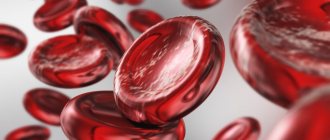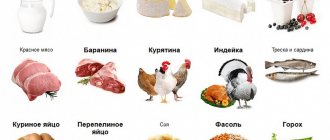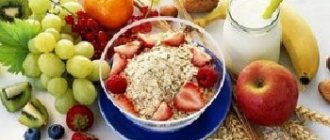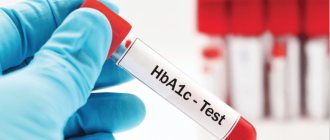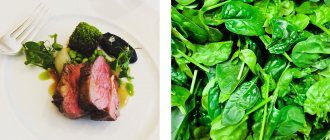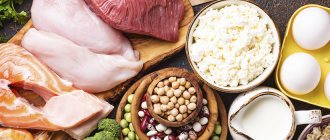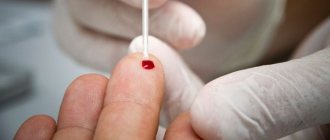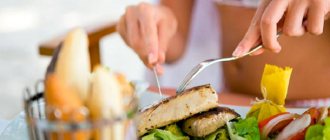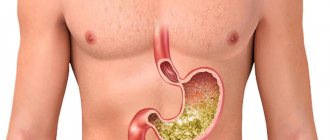Hemoglobin is an organic protein found in red blood cells (erythrocytes). Its main purpose is to transport oxygen throughout all tissues.
Almost 80% of hemoglobin consists of iron, which combines with oxygen (the process of its oxidation and then reduction occurs).
According to research , it is the lack of iron in the body that most often provokes a sharp drop in hemoglobin levels.
In this article, we will discuss which fruits and vegetables should be included in the diet to normalize the concentration of hemoglobin in the blood. You will also learn the dangers of reducing its level.
Symptoms of low hemoglobin and consequences
For an adult, the normal hemoglobin level is as follows:
- for women – from 120 to 150 g/l;
- for men – from 130 to 160 g/l.
In old age, the hemoglobin level in most cases increases up to 180 g/l - this is not considered a dangerous deviation and, as a rule, is assessed as a “stable norm”. In pregnant women, the range of normal levels also expands slightly and can range from 110 to 155 g/l - this is due to temporary changes in blood flow.
Doctors identify the following symptoms of low hemoglobin:
- a feeling of constant fatigue (even if a person sleeps a fairly large amount of time and follows a day and night routine);
- regular headache without changes in blood pressure;
- manifestation of yellowness of the skin;
- deterioration of skin and nails;
- muscle weakness;
- dyspnea;
- slight decrease in blood pressure.
- In critical cases, a person may lose consciousness.
Why is low hemoglobin so dangerous? Oxygen starvation of all organs, the brain, which accelerates the process of deactivation of nerve cells. Along with this, muscle atrophy develops, the walls of blood vessels become thinner and less resistant to rupture (with low hemoglobin, subcutaneous bleeding in the form of capillary networks often occurs).
Also, low hemoglobin may be accompanied by persistent angina and the development of other chronic diseases of the cardiovascular system.
Low hemoglobin is especially dangerous for newborns. In the first few months, the norm for them is from 180 to 240 g/l. This is due to the fact that at this time their nervous system is still actively developing and this is what oxygen is used for. A drop in hemoglobin to 130 g/l can trigger the development of brain pathologies.
It is worth considering that an increased level of hemoglobin also harms the body. In this case, blood viscosity increases, increasing the risk of thrombosis. Also, increased hemoglobin is accompanied by nervousness and decreased resistance to stress.
Increased hemoglobin
This condition is also dangerous. Blood viscosity increases, and therefore there is a risk of developing thrombosis.
Next we will talk about what fruits you can eat with high hemoglobin. Green fruits should be included in your diet. They contain minimal amounts of iron.
Interferes with the absorption of the microelement calcium. Accordingly, in order to lower hemoglobin, it is necessary to consume cheese, feta cheese, condensed milk, milk chocolate, cottage cheese, wheat bread, pasta, yogurt, curdled milk, boiled shrimp and crab, and butter as often as possible.
Top 10 healthy vegetables and fruits
It is best to include in your diet those vegetables and fruits that contain iron and other metals as trace elements. The same zinc and magnesium regulate hematopoietic function, and iron is used to produce hemoglobin. Also, those vegetables and fruits that contain a sufficiently high content of vitamins PP, K, C, and E help increase its concentration.
Beet
Beetroot juice increases hemoglobin very well. It is enough to consume it at least 20 - 30 milliliters per day in order to increase hemoglobin by 10 g/l within a week.
Another feature of beets is that they retain their beneficial properties even when cooked, and they also provide the body with the lion’s share of indigestible fiber (which helps normalize intestinal function, thereby receiving more micronutrients from food).
Pomegranate
Including pomegranate fruits in the diet helps normalize hematopoietic function and raise blood pressure. Pomegranate also perfectly raises hemoglobin.
Doctors also say that pomegranate helps prevent headaches. But it is grains that should be consumed, but it is better to avoid concentrated pomegranate juice - its use leads to a sharp increase in hemoglobin levels in a short period of time, which can cause angina pectoris. If you do drink juice, then dilute it with water in a ratio of 1 to 3.
Apples
Of the common fruits, apples have the highest concentration of iron . It is because of this that a cut apple quickly becomes covered with a brown film (or rather, its pulp). This occurs due to the oxidation of iron molecules.
How many apples should you eat daily to increase hemoglobin? About 3 – 4 medium-sized fruits will be more than enough. If you give preference to concentrated juice, then you should drink it in small portions - only 20 - 30 milliliters. Apples are also an excellent source of vitamins A, C, E and PP.
Bananas
Bananas are also good for hemoglobin, since they contain a large amount of folic acid (vitamin B6), and it stimulates the absorption of iron . Without this vitamin, ferum is simply not synthesized into hemoglobin and literally immediately after consumption it is excreted along with feces.
For those who do not like bananas or who are not recommended to eat them (for example, with diabetes, obesity, chronic diseases of the gastrointestinal tract), you can prepare jelly from dried bananas. The only caveat is that this jelly is first washed 2 or 3 times with water (standing for at least 20 - 30 minutes). This will help retain all the fiber but reduce the concentration of carbohydrates.
Grapefruit
Grapefruit is a source of vitamins C and PP (contained in the zest and just gives it a bitter taste).
Also, eating citrus fruits (oranges, lemon and others) speeds up metabolism and helps absorb iron faster.
Just don’t overuse grapefruit - excess ascorbic acid also harms the body (increases blood viscosity, provokes red blood cell adhesions).
Ginger
Ginger root also has a positive effect on the blood. Moreover, you need to consume only 5–10 grams of this product per day to improve the functioning of the cardiovascular system and prevent oxygen starvation. Ginger also cleans blood vessels.
It is recommended to consume ginger fresh or dried, but not canned (upon contact with acetic acid, the essential oils included in the composition break down into their simplest elements).
Garlic
It is a good source of vitamin C and also contains a wide range of essential oils and resins that help the body absorb iron faster .
Another feature of garlic is that it accelerates the process of removing toxins (including inorganic types), which can provoke a sharp decrease in the level of hemoglobin in the blood to a critical level.
Sauerkraut
It contains ascorbic acid, and in almost the same concentration as in lemon (per kilogram - about 350 milligrams of vitamin C).
And red sauerkraut also contains a small amount of iron - it is more preferable for increasing hemoglobin.
Sea kale
Rich in iron, zinc, magnesium, vitamin PP and folic acid. Many doctors consider this product to be the most beneficial for the cardiovascular system.
Every day it is recommended to eat at least 30 grams of seaweed in any form (pickled and pickled are the most common options).
Spinach
Among greens, it is the richest in iron (almost 12 mg per 100 grams of fresh product).
It is recommended to consume it fresh, adding it to various types of salads. Goes well with olive oil and garlic.
Sample menu
It is important to eat not only vegetables and fruits that increase hemoglobin. The diet should be both varied and complete.
You need to eat 6 times a day. In this case, the total serving size consumed at one time should not exceed 200 g.
The following products are best for breakfast: fish and meat (boiled), vegetable stew, porridge (buckwheat, rice or oatmeal), bread, boiled egg (chicken or quail), freshly squeezed juice. In the morning you need to eat one or two dishes.
During the second breakfast, you can eat fried fish, beets, carrots, stewed cabbage or tomatoes. During this period, it is best to drink food with milk.
Lunch should be filling. You need to eat the first and second courses, as well as dessert. The best options for lunch are: soup (any kind, but with meat broth), liver (fried or in the form of pate), porridge, vegetable salads, fruits, cheese, juice.
During the afternoon snack, it is recommended to give preference to berries. If they are absent, use fruit.
For dinner, it is advisable to eat a dish of meat or fish. As an alternative, stewed vegetables and cottage cheese casserole can be used.
Before going to bed, it is recommended to drink a glass of yogurt or kefir daily.
What should be excluded from the diet?
A decrease in hemoglobin levels is facilitated by:
- Almost all dairy products. They contain protein and complex carbohydrates, which slow down the process of hemoglobin synthesis. Milk also thickens the blood.
- Pasta. This also includes all cereals. They interfere with the absorption of iron, oxidizing it while still in the gastrointestinal tract. Such a micronutrient is no longer suitable for the formation of hemoglobin cells.
- Chicken eggs. It is the protein they contain that lowers hemoglobin. In principle, any food based on protein slows down the absorption of iron.
- Wheat flour and all products derived from it. Regular consumption of wheat bread leads to a decrease in hemoglobin by an average of 15 g/l. Therefore, it is better to give preference to black or coarsely ground bread (bran).
Doctors' recommendations
Most patients are only interested in what fruits increase hemoglobin and what else they need to eat to normalize the level of organic protein in the blood. Practice shows that it is not always enough to just make adjustments to your diet. It is necessary to take into account some nuances.
Doctors' recommendations:
- Pasta, wheat bread and alcohol-containing drinks should be excluded from the menu. This is due to the fact that they interfere with the absorption of iron. The trace element is oxidized in the gastrointestinal tract, due to which hemoglobin can no longer be synthesized from it. As an exception, it is permissible to drink 50 ml of red wine with dinner.
- Meals must be fractional.
- It is important to know not only which fruits increase hemoglobin in the blood, which foods, vegetables and juices to give preference, but also that the iron from them is not fully absorbed, but only partially. In this regard, doctors recommend additionally taking medications containing microelements. The most effective are the following products: “Ferrum Lek”, “Sorbifer Durules”, “Tardiferon”, “Irovit”, “Heferol”.
It is not prohibited to turn to alternative medicine methods. For example, a decoction based on red clover helps increase hemoglobin.
Features of nutrition during pregnancy
During pregnancy, almost all vitamins are rapidly consumed in a girl’s body, including folic acid (B6). It is the last element that needs to be paid the most attention.
When carrying a child, folic acid is primarily used by the endocrine system to normalize the balance of sex hormones (which regulate the pregnancy process itself and prevent the premature birth of a child).
So, it is necessary to include bananas and fish in your diet (it contains omega-3 acids, which help absorb B vitamins).
The same goes for vegetables and fruits that contain iron. Some of these microelements are used by the body to form the cardiovascular system of the unborn child, so in women during this period, hemoglobin is constantly reduced (and remains so until the beginning of the third trimester of pregnancy).
Foods that increase hemoglobin
In order for the organic protein level to be normal, women need to consume at least 18 mg of iron daily, men - 10 mg. At the same time, the diet should include not only vegetables and fruits. It is also possible to increase hemoglobin with animal products.
You must include in your diet:
- liver (pork, chicken, beef);
- beef;
- lamb;
- pork;
- chicken;
- turkey;
- heart (beef and pork);
- language.
In addition, the following foods are rich in iron:
- mussels;
- oysters;
- sardines;
- yolk of chicken and quail eggs;
- pistachios;
- spinach;
- peas;
- lentils;
- porridge: barley, buckwheat, millet, oatmeal;
- peanut;
- cashew nuts;
- Pine nuts;
- corn;
It is important to know not only what foods and fruits increase hemoglobin. It is necessary to regularly eat foods rich in vitamins C and B6. Thanks to these substances, iron will be better absorbed in the body.
